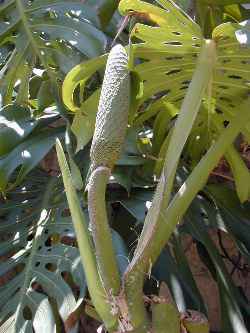Sunset®: 16,17,21-27
USDA: 10
Frost Tolerance: Needs frost protection in Phoenix, foliage damaged at 32° F (0° C), serious damage at 30° F (-1° C)
Sun Exposure: Filtered shade
Origin: Mexico to South America
Growth Habits: Evergreen vines
Watering Needs: Regular water
Propagation: Propagation is possible by stem cuttings (they will root in water), or seeds

This Central American plant has been more widely cultivated as an ornemental than as a fruit plant, but its edible qualities are well known.
Monstera is a vigorous, creeping or climbing vine with thick stems and heart shaped leaves often 2 feet wide and 3 feet long (60 by 90 cm) in tropical climates (in Phoenix, 1 foot by 1.5 foot is more usual - 30 by 45 cm). The leaves are both deeply lobed and perforated near the center.
Blooming Habits:
The flowers, which are like huge arum lilies, appear on short thick stems during the summer if the humidity conditions are good. The central spadix develops into a cylindrical dark green fruit 8 to 10 inches long (20 to 25 cm) and 2 to 3 inches in diameter (5 to 7.5 cm).
Culture:
Avoid direct sun and keep it above 30 degrees (which is relatively easy if it is in a sheltered place). The plants suffers below 50 degrees. If protected it will survive Phoenix winters.
When growing outside, if the conditions are right, the Monstera might start blooming 3 years after being planted. The edible fruit ripens one year after blooming. It is important to wait until the fruit is ripe, that is that the green rind knocks off easily, to taste it. Before that the fruit contains enough oxalic acid to be painfully caustic.
Propagation:
The monstera may be propagated by seeds, but seedlings are slow in development. Tip cuttings are more rapid, and these may be set in the permanent location if the temperature is warm enough. Where a number of plants are desired, the vine may be divided into 1-foot sections (30 cm), which are pressed halfway into the surface of a bed of mixed leafmold and sand. When the sprouts have developed roots, they may be transplanted to the permanent location.
Desert-Tropicals is dedicated to provide gardening advice, gardening ideas, and information about flower of all kind for landscape and collections.We try to check carefully the identification of the plants on the illustrations as well as the other information from the page, but occasionally errors do occur. if you notice anything that needs to be changed please contact us.Thanks.
© 1998-2020 Philippe Faucon, All Rights Reserved.
